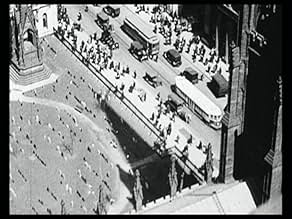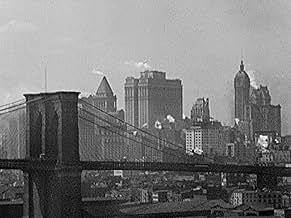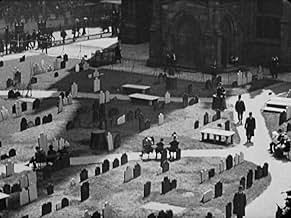IMDb RATING
6.6/10
1.7K
YOUR RATING
This groundbreaking silent documentary captures the beauty and majesty of the New York City in its streets, skyscrapers, bridges, rail yards and harbors.This groundbreaking silent documentary captures the beauty and majesty of the New York City in its streets, skyscrapers, bridges, rail yards and harbors.This groundbreaking silent documentary captures the beauty and majesty of the New York City in its streets, skyscrapers, bridges, rail yards and harbors.
- Directors
- Writer
- Awards
- 1 win total
Featured reviews
This groundbreaking silent documentary captures the beauty and majesty of the New York City in its streets, skyscrapers, bridges, rail yards and harbors.
Is this film groundbreaking? I would have to agree with that. But unfortunately, it doesn't break nearly as much ground as it could. The film reminds me of "Berlin", the documentary made by Karl Freund and Carl Mayer, among others. The big difference being that "Manhatta" is not particularly long.
And that is why I can only give it so much love, because I wish more of 1920s New York was captured on film, an era that is still remembered fondly today (2017). Any document would be somewhat priceless to the right people.
Is this film groundbreaking? I would have to agree with that. But unfortunately, it doesn't break nearly as much ground as it could. The film reminds me of "Berlin", the documentary made by Karl Freund and Carl Mayer, among others. The big difference being that "Manhatta" is not particularly long.
And that is why I can only give it so much love, because I wish more of 1920s New York was captured on film, an era that is still remembered fondly today (2017). Any document would be somewhat priceless to the right people.
10DaveLB-3
Instead of having a filmmaker attempting to be painterly, this poetic gem boasts both a major painter (Sheeler) and a major photographer (Strand) collaborating.
This is the earliest view of Manhattan we have that is neither simple-minded documentation nor backdrop to melodrama. The visuals are striking, and stand up well to later, more gimmicky, film realizations of what makes Skyscraper National Park so special.
The Walt Whitman title cards would probably have worked better as voiceover narration in the sound era, but offer a strong romantic framework for the powerful imagery. A classic, not to be missed.
This is the earliest view of Manhattan we have that is neither simple-minded documentation nor backdrop to melodrama. The visuals are striking, and stand up well to later, more gimmicky, film realizations of what makes Skyscraper National Park so special.
The Walt Whitman title cards would probably have worked better as voiceover narration in the sound era, but offer a strong romantic framework for the powerful imagery. A classic, not to be missed.
Cinema had matured enough in the year 1921 to allow imaginative experimentation with celluloid. Two photographers combined Walt Whitman's lines of poetry with 65 filmed shots of New York City's Manhattan Island to produced their short movie 1921's "Manhatta." Some cite the pair's brief film as the first avant-garde work in moving pictures.
Charles Sheeler, a painter/photographer, and Paul Strand, photographer, decided to base their short project on passages from Whitman's 'Leaves of Grass.' They set their motion picture camera high above the city landscape, framing each of their 65 shots like they were using a still camera, dictating the artistry of the city's buildings and transport vehicles to determine its positioning. The camera rarely moves during each shot and sustains mostly wide shots of the city.
Not only does "Manhatta" serve as a fascinating historic photographic record of New York City over 100 years ago, it also reflects how humans apoear to be overwhelmed by the gigantic concrete structures and mammoth transports surrounding them. One particular visual exemplifying such magnitude is when a horde of workers crowd the stern of a ferry and unload in a rush to get where they need to go.
"Manhatta" was rarely shown after its completion, and when it did the movie was more of a curiosity. In 1950, a worn print of the short was discovered in a British film vault, and an archivist, beginning in 2005, spent four years to restore it to its current pristine form.
Charles Sheeler, a painter/photographer, and Paul Strand, photographer, decided to base their short project on passages from Whitman's 'Leaves of Grass.' They set their motion picture camera high above the city landscape, framing each of their 65 shots like they were using a still camera, dictating the artistry of the city's buildings and transport vehicles to determine its positioning. The camera rarely moves during each shot and sustains mostly wide shots of the city.
Not only does "Manhatta" serve as a fascinating historic photographic record of New York City over 100 years ago, it also reflects how humans apoear to be overwhelmed by the gigantic concrete structures and mammoth transports surrounding them. One particular visual exemplifying such magnitude is when a horde of workers crowd the stern of a ferry and unload in a rush to get where they need to go.
"Manhatta" was rarely shown after its completion, and when it did the movie was more of a curiosity. In 1950, a worn print of the short was discovered in a British film vault, and an archivist, beginning in 2005, spent four years to restore it to its current pristine form.
Preface: Due to the nature of such a short film, any valid review will contain some evidence of a "spoiler." This review is no exception.
Paul Strand's "Manhatta" is more than just the simple, pioneering piece in early cinema. "Manhatta" is a representation of New York City through the eyes of a still photographer. Strand uses the format of motion picture to create a sense of life. Similar to his New York still photography, each moving image frames city life, angles, and other objects with semi-avant-garde detail. Strand's own "mentor," Alfred Stieglitz, greatly appreciated the new form of city photography, publishing it in "Camera Work" and in his gallery 291.
In the movie, the blowing smoke, walking people, moving ships, and other objects in motion are what separate the motion picture from a photo album. Instead of portraying New York as an iconic, prosperous city, Strand has been able to portray New York City as an organism that contains a immigrant working class.
In my opinion, "Manhatta" commands the respect of many early motion pictures, influencing many great, more popular films.
Paul Strand's "Manhatta" is more than just the simple, pioneering piece in early cinema. "Manhatta" is a representation of New York City through the eyes of a still photographer. Strand uses the format of motion picture to create a sense of life. Similar to his New York still photography, each moving image frames city life, angles, and other objects with semi-avant-garde detail. Strand's own "mentor," Alfred Stieglitz, greatly appreciated the new form of city photography, publishing it in "Camera Work" and in his gallery 291.
In the movie, the blowing smoke, walking people, moving ships, and other objects in motion are what separate the motion picture from a photo album. Instead of portraying New York as an iconic, prosperous city, Strand has been able to portray New York City as an organism that contains a immigrant working class.
In my opinion, "Manhatta" commands the respect of many early motion pictures, influencing many great, more popular films.
One of the earliest "city symphonies", and arguably one of the most groundbreaking avant garde films of the 1920's, 'Manhatta' is a lyrical, slow, and moving tribute to a great American city based loosely off of a Walt Whitman poem. The imagery isn't as intense and vibrant as that in many other films of a similar nature, whether they be other city symphonies or just other avant garde/experimental films in general, but there are several shots in here that definitely widened my eyes. The very specific positioning of the camera for certain angles helped give much of the short film a very epic feel. At some points, it even felt extremely futuristic and, to me, evoked some shots from Fritz Lang's legendary classic 'Metropolis'. It's only about twelve minutes, so any fan of experimental film might as well check it out as it is highly revolutionary and visually pleasing.
Did you know
- TriviaThe poet whose works are quoted during the film is Walt Whitman.
- Quotes
Title Card - Walt Whitman: "City of the world - for all races are here, City of tall facades of marble and iron, Proud and passionate city."
- Alternate versionsThis film was published in Italy on an DVD anthology entitled "Avanguardia: Cinema sperimentale degli anni '20 e '30", distributed by DNA Srl. The film has been re-edited with the contribution of the film history scholar Riccardo Cusin . This version is also available in streaming on some platforms.
- ConnectionsFeatured in The Secret Life of Sergei Eisenstein (1987)
Details
- Runtime11 minutes
- Color
- Sound mix
- Aspect ratio
- 1.33 : 1
Contribute to this page
Suggest an edit or add missing content




















